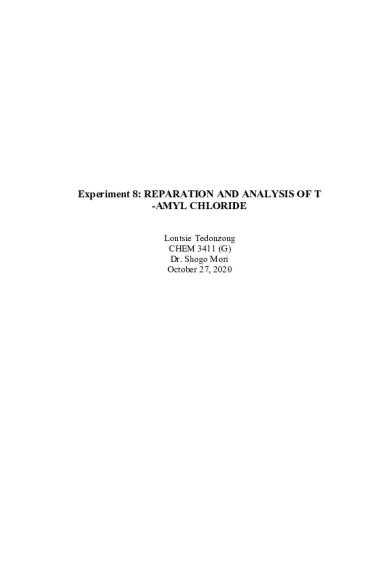Experiment 8- Reparation AND Analysis OF T -AMYL Chloride PDF

| Title | Experiment 8- Reparation AND Analysis OF T -AMYL Chloride |
|---|---|
| Course | Genetics |
| Institution | Augusta University |
| Pages | 6 |
| File Size | 326.2 KB |
| File Type | |
| Total Downloads | 63 |
| Total Views | 121 |
Summary
lab report...
Description
Experiment 8: REPARATION AND ANALYSIS OF T -AMYL CHLORIDE Lontsie Tedonzong CHEM 3411 (G) Dr. Shogo Mori October 27, 2020
I.
INTRODUCTION
The purpose of this experiment was to synthesize T-amyl chloride. In other to do this, a substitution reaction occurred. In a substitution reaction, an alkyl halide undergoes a nucleophilic attack from the nucleophile. The hydrochloric acid which was used in this experiment protonated the alcohol to enable it to function as a good leaving group, since compounds with good leaving groups often participate in substitution reactions. To carry out this experiment, a separatory funnel was to separate the immiscible liquid, a fractional distillation technique was used to purify the mixture, temperature while heating the mixture was recorded, and an IR spectroscopy was done to analyse the product.
II.
EXPERIMENTAL SECTION
First, 18mL of concentrated hydrochloric acid was cooled in an E-flask with an ice water bath. The cold acid was transferred to a separatory funnel. 4.891g of t-amyl alcohol was added. The mixture was shook, mixing the layers for a about 10minutes. The layers were allowed to cleanly separate and the aqueous layer was removed. The product layer was first washed with 10 mL of water it was shook, then the water layer was removed and then with 10 mL of 5% sodium bicarbonate solution was added, swirled, and shook .The layers were allowed to cleanly separate and the aqueous layer was removed (sodium bicarbonate layer). Finally, the product layer was washed with 10 mL of saturated NaCl solution (brine). After the product was washed, it was drained into a dry small E-flask making sure to limit any traces of water. The product was dried over anhydrous sodium sulfate. Then, the product was decanted from the drying agent into a small round bottom flask and purify it by fractional distillation, using a small fractionating column, into pre-weighed vials (13.668g). The boiling point of the product fractions were recorded. The yield was determined. Finally, an IR spectrum of the product and the starting reagent were done to confirm the outcome of the synthesis.
Fractional Distillation
III.
RESULTS AND DISCURSION
The first IR spectrum shown above is that of T-amyl chloride and the second is t-amyl alcohol. The first spectrum is different than the second in that, the second IR has an O-H stretching peak around 3360 cm-1 and the first does not, which is associated with the O-H bond stretch of the water molecule. The fist does not have the O-H because it was well dried.
Theoretical yield of T-amyl chloride: (106g/mol(C5H11Cl)* 4.891g of t-amyl alcohol/88.15g/mol(C5H12O))= 5.88g Actual yield= 4.705g Percent yield= (4.705g/5.88g)*100= 80.02% Since the percent yield is 80.02%, some of the product was lost during the process. Some might have been lost in the separatory funnel or not all of the product evaporated during distillation. Water, 5% sodium bicarbonate and NaCl(brine), were used to wash the product layer. This was to pre-dry the organic layers and avoid product lost into the aqueous phase
Boiling Point of T-amyl chloride: 71°C- 74 °C This boiling point was lower than the literature boiling point of 85.5°C. This means that the substance contained some impurities.
Step 1: Protonation of the hydroxyl group Step 2: Loss of the leaving group to form a carbocation.
Step 3: Chloride nucleophile attacks the nucleophile. Tert amyl alcohol reacts with HCl to produce T-amyl chloride by an SN1 reaction. The limiting reagent is t-amyl alcohol
Observed Absorption
Type of Vibration
Functional group
intensity
2979
Strech
C-H
Strong
1153
Strech
C-O
Strong
794
Sretch
C-Cl
Strong
IV. CONCLUSION In conclusion, T-amyl chloride was successfully synthesized. If it still contained some water molecules, the water molecule could react with the product by nucleophilic substitution to form the alcohol again but it was not the case as the IR spectrum shows. Also, the percent yield was large (80.02%), meaning much was recovered.
REFERENCES 1. Augusta University Department of Chemistry. Experiment 8. Preparation and analysis of T-amyl chloride. 2. “Fractional Distillation Vector Illustration. Labeled Educational..” 123RF, www.123rf.com/photo_137088959_stock-vector-fractional-distillation-vector-illustrationlabeled-educational-technology-process-scheme-physics-me.html. 3. “Separating Funnel.” Separation Techniques, purificationikwok.weebly.com/separatingfunnel.html. 4. “2-Chloro-2-Methylbutane.” National Center for Biotechnology Information. PubChem Compound Database, U.S. National Library of Medicine, pubchem.ncbi.nlm.nih.gov/compound/2-Chloro-2-methylbutane....
Similar Free PDFs
Popular Institutions
- Tinajero National High School - Annex
- Politeknik Caltex Riau
- Yokohama City University
- SGT University
- University of Al-Qadisiyah
- Divine Word College of Vigan
- Techniek College Rotterdam
- Universidade de Santiago
- Universiti Teknologi MARA Cawangan Johor Kampus Pasir Gudang
- Poltekkes Kemenkes Yogyakarta
- Baguio City National High School
- Colegio san marcos
- preparatoria uno
- Centro de Bachillerato Tecnológico Industrial y de Servicios No. 107
- Dalian Maritime University
- Quang Trung Secondary School
- Colegio Tecnológico en Informática
- Corporación Regional de Educación Superior
- Grupo CEDVA
- Dar Al Uloom University
- Centro de Estudios Preuniversitarios de la Universidad Nacional de Ingeniería
- 上智大学
- Aakash International School, Nuna Majara
- San Felipe Neri Catholic School
- Kang Chiao International School - New Taipei City
- Misamis Occidental National High School
- Institución Educativa Escuela Normal Juan Ladrilleros
- Kolehiyo ng Pantukan
- Batanes State College
- Instituto Continental
- Sekolah Menengah Kejuruan Kesehatan Kaltara (Tarakan)
- Colegio de La Inmaculada Concepcion - Cebu
